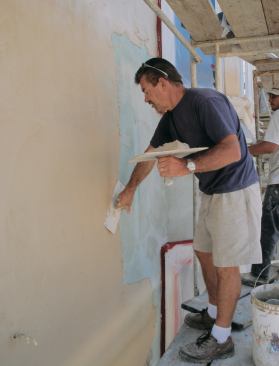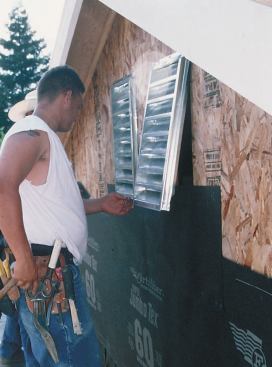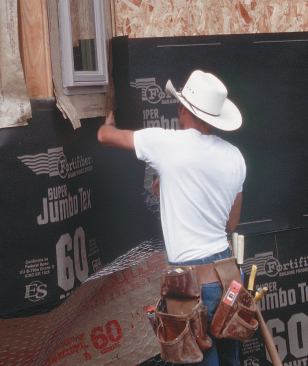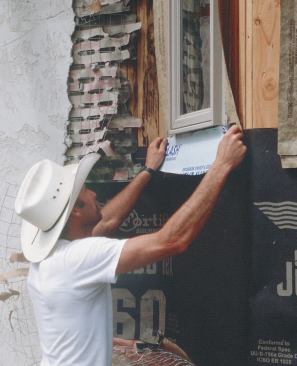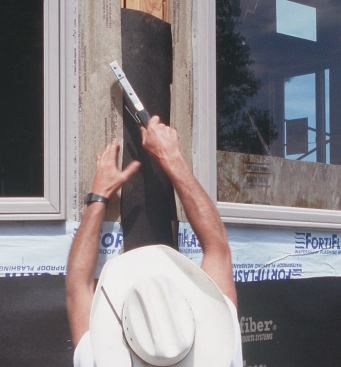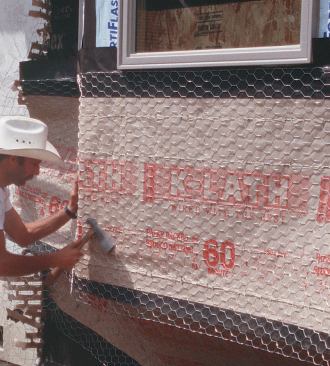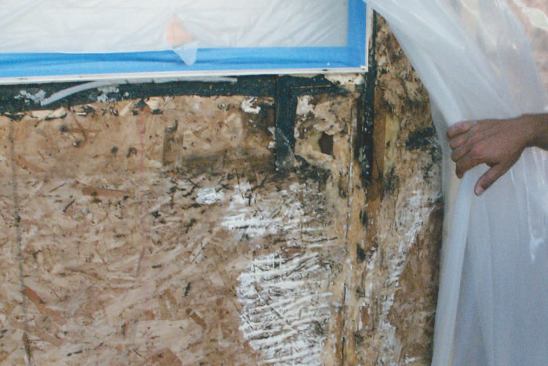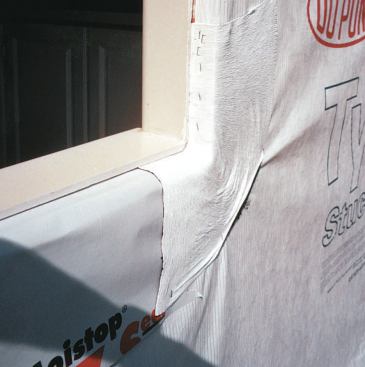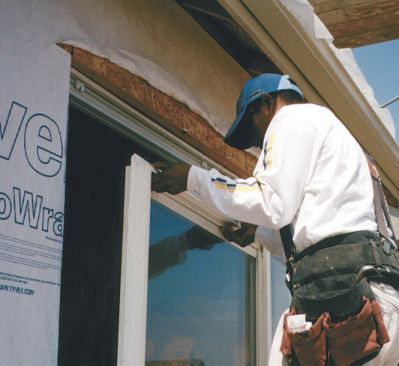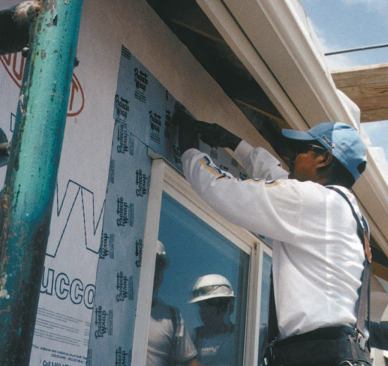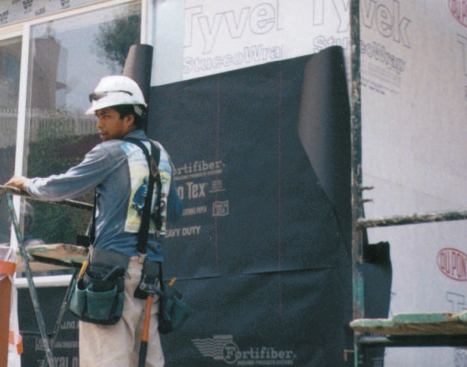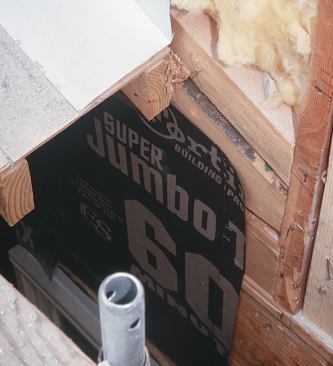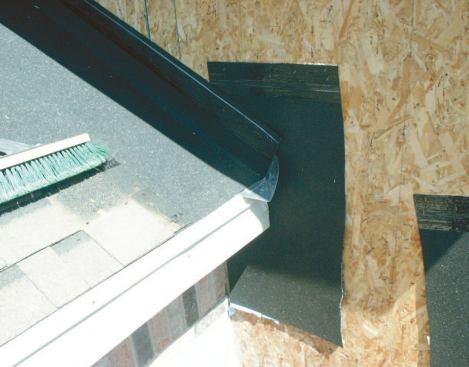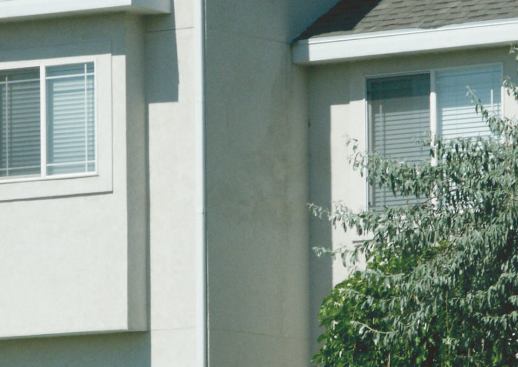Roof-to-wall joints. The most damaging leakage we see in our work takes place where roofs intersect walls, either because a one-story roof meets a two-story wall, or because a chimney chase meets the roof. It takes work to keep the roofers and the stucco applicators coordinated so that their work interweaves correctly.
Every roof needs some kind of L-shaped flashing where the roof abuts the wall. Metal step flashing, or as we call it, “step shingles,” is typical for asphalt or shake roofs; tile roofs usually get a continuous piece of metal J flashing.
Where stucco is new in the market, the appropriate metal step shingles for stucco application can be hard to find. Folded flashings intended for use with asphalt shingles and vinyl siding are too small for stucco. In Salt Lake City, the typical step shingles on the shelf are 8 inches long, with a 2-inch leg for the wall and a 4-inch leg for the roof. Stucco requires a 2-inch reveal between the bottom termination of the stucco and the roof surface (many EIF systems need a 3-inch reveal), and a 2-inch lap of the building paper over the metal, so step flashings must have at least a 4-inch vertical leg.
Since you can’t be sure of finding the right size metal flashings in all markets, I always use rubberized asphalt sheet material like Ice and Water Shield as a backup.
However, the flashings are still important, particularly the water diverter or “kickout flashing” at the bottom of the roof, which kicks roof runoff away from the wall system. Where this is not installed, water from the roof will overwhelm the stucco system and cause at least a visual problem, and commonly a major structural problem.
Penetrations. Every penetration in the stucco — hose bibb, dryer vent, combustion air intake, or whatever — is a potential leakage point. Our solution for those spots is to use bent and soldered metal to make up a set of standard shrouds, like the hoods that cover dryer vents, in various sizes to meet the most common needs. We caulk the back side of the shroud to the paper below it, and caulk the paper above it to the shroud’s top and side flanges. Then we terminate the stucco at a casing bead.
Homeowners Pay the Price
In Salt Lake City, my stucco repair business is thriving. We also have a lot of work fixing homes with EIFS and cultured stone exteriors — the underlying drainage-plane problems are the same.
Recently, I started a company, Ram Exteriors, to install hard-coat stucco on new homes. But I’m thinking of shutting it down. We haven’t been able to get much business, and we have barely broken even on the jobs we have sold. The cut-rate competition is just too tough. It’s ironic, but I can find plenty of work fixing bad stucco at four times the cost, and very little work applying stucco right in the first place.
The consequences are tragic for homeowners who don’t understand the issues. I was called to do an estimate on one house up for sale, where the buyer had hired a home inspector from back East and the inspector had flagged the stucco system. I told the buyers they were looking at a system that was trying to drain water on the exterior and lacked the right flashings and papers under the cladding. Even if we found no structural damage, I told them, it would be at least $30,000 to retrofit the home to provide good drainage details.
That buyer backed out of the sale. But I heard that the house sold weeks later to another buyer who did not have a home inspection done. Someone has bought the trouble.
I worked for another couple who bought their home before they saw any problem. They called me because of leaks and musty odors. When my crew started to open the walls, the foreman called me from the site and said, “You better get over here, Dennis. This house is about to fall down.” When I got there, sure enough — the home’s framing was almost gone. There was a risk of imminent collapse.
Utah has some of the weakest liability laws in the U.S. That couple’s lawyer advised them to settle for $50,000. In other states, the builder would have been on the hook for the whole value of the house. If the builder’s insured, that’s a hit he can handle — once, and then lose his coverage. But I know some contractors who have thought they were covered and never were: Exclusions they hadn’t read in their insurance policies ruled stucco out, and they didn’t even know it.
Whether your insurance covers you for stucco failure or not, that isn’t a road you need to go down. The way to prevent the human cost isn’t with insurance. Insurance is for unavoidable disasters, one-time deals. If stucco is done wrong, failure is predictable: You can expect it. And the way to avoid stucco failure is simple: Provide the system of flashings and papers that will keep water away from the wood. If you do, you’ll have something better than insurance: a weather-resistant home exterior that does its job.
Lifelong contractor Dennis McCoyowns and operates Ram Builders, Inc. (www.rambuilders.com), based in Lindon, Utah, with operations in Utah, Texas, and California.
